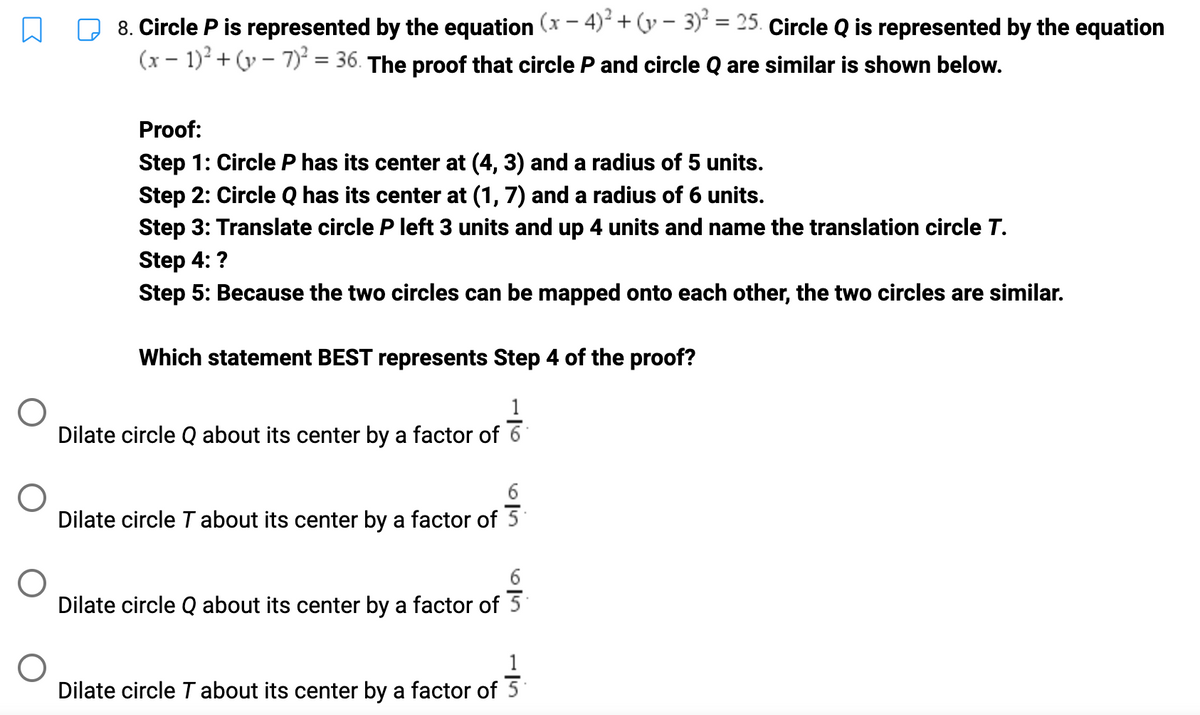8. Circle P is represented by the equation (x − 4)² + (x − 3)² = 25. Circle Q is represented by the equation (x − 1)² + (y-7)² = 36. The proof that circle P and circle Q are similar is shown below. Proof: Step 1: Circle P has its center at (4, 3) and a radius of 5 units. Step 2: Circle Q has its center at (1, 7) and a radius of 6 units. Step 3: Translate circle P left 3 units and up 4 units and name the translation circle T. Step 4: ? Step 5: Because the two circles can be mapped onto each other, the two circles are similar. Which statement BEST represents Step 4 of the proof? 1 Dilate circle Q about its center by a factor of 6 6 Dilate circle T about its center by a factor of Dilate circle Q about its center by a factor of 5 1 Dilate circle T about its center by a factor of 5
8. Circle P is represented by the equation (x − 4)² + (x − 3)² = 25. Circle Q is represented by the equation (x − 1)² + (y-7)² = 36. The proof that circle P and circle Q are similar is shown below. Proof: Step 1: Circle P has its center at (4, 3) and a radius of 5 units. Step 2: Circle Q has its center at (1, 7) and a radius of 6 units. Step 3: Translate circle P left 3 units and up 4 units and name the translation circle T. Step 4: ? Step 5: Because the two circles can be mapped onto each other, the two circles are similar. Which statement BEST represents Step 4 of the proof? 1 Dilate circle Q about its center by a factor of 6 6 Dilate circle T about its center by a factor of Dilate circle Q about its center by a factor of 5 1 Dilate circle T about its center by a factor of 5
Trigonometry (MindTap Course List)
8th Edition
ISBN:9781305652224
Author:Charles P. McKeague, Mark D. Turner
Publisher:Charles P. McKeague, Mark D. Turner
Chapter1: The Six Trigonometric Functions
Section: Chapter Questions
Problem 2GP
Related questions
Question

Transcribed Image Text:8. Circle P is represented by the equation (x − 4)² + (y - 3)² = 25. Circle Q is represented by the equation
(x - 1)² + (y-7)² = 36. The proof that circle P and circle Q are similar is shown below.
Proof:
Step 1: Circle P has its center at (4, 3) and a radius of 5 units.
Step 2: Circle Q has its center at (1, 7) and a radius of 6 units.
Step 3: Translate circle P left 3 units and up 4 units and name the translation circle T.
Step 4: ?
Step 5: Because the two circles can be mapped onto each other, the two circles are similar.
Which statement BEST represents Step 4 of the proof?
Dilate circle Q about its center by a factor of 6
Dilate circle T about its center by a factor of 5
Dilate circle Q about its center by a factor of 5
1
Dilate circle T about its center by a factor of 5
Expert Solution
This question has been solved!
Explore an expertly crafted, step-by-step solution for a thorough understanding of key concepts.
This is a popular solution!
Trending now
This is a popular solution!
Step by step
Solved in 3 steps

Recommended textbooks for you

Trigonometry (MindTap Course List)
Trigonometry
ISBN:
9781305652224
Author:
Charles P. McKeague, Mark D. Turner
Publisher:
Cengage Learning

Mathematics For Machine Technology
Advanced Math
ISBN:
9781337798310
Author:
Peterson, John.
Publisher:
Cengage Learning,

Algebra & Trigonometry with Analytic Geometry
Algebra
ISBN:
9781133382119
Author:
Swokowski
Publisher:
Cengage

Trigonometry (MindTap Course List)
Trigonometry
ISBN:
9781305652224
Author:
Charles P. McKeague, Mark D. Turner
Publisher:
Cengage Learning

Mathematics For Machine Technology
Advanced Math
ISBN:
9781337798310
Author:
Peterson, John.
Publisher:
Cengage Learning,

Algebra & Trigonometry with Analytic Geometry
Algebra
ISBN:
9781133382119
Author:
Swokowski
Publisher:
Cengage
